Flower bulbs push the gardening year right up to the edge of winter and there’s nothing more uplifting than the first garden blooms! For me, one of the greatest joys of gardening is seeing those first spring bulbs breaking through the earth as if by magic.

If you enjoy an early spring bulb garden, you’ve probably thought how wonderful it would be to keep those beautiful blooms going from early spring to summer. Fortunately, with the extensive variety of flower bulbs available today, you can easily achieve a long spring season by planting early, middle, and late-blooming bulbs.

While spring bulbs are in their glory, take a few minutes to evaluate your own garden and perhaps visit others for some flowery inspiration, then plan on ordering your bulbs early before they sell out. As you browse catalogs or websites, try to visualize what you’d like to see in your garden and choose a color palette that appeals to you. Next, pick your favorite early spring bloomers and extend their season’s beauty by using the early, middle, and late-flowering variety plan.

For example, Daffodil bulbs can bloom as early as late February here in Northeast Massachusetts and bright yellow Rijnveld’s Early Sensation is one of the earliest. Snowdrops and crocus are also very early bloomers and would make good companions. Ice Follies, a classic early to mid-season bloomer, looks stunning with the smaller bulbs of Early Snow Glories (Chionodoxa forbesii), Hyacinth, and Siberian Squill (Scilla siberica). Thalia, a pristine white beauty, blooms next along with Grape Hyacinth (Muscari armeniacum) and old-fashioned Bleeding Heart while late-season Pheasant’s Eye looks lovely with the stately globe alliums as well as early spring perennials.

You can try this method with many spring bulbs including Tulips, Alliums, Hyacinths, Daffodils, and of course the earliest bloomers such as Snowdrops and Crocus. Something to keep in mind is that smaller flower bulbs make great supporting stars for their larger spring cousins!

Seek inspiration and plan your bulb garden now, purchase and reserve bulbs early to get the best varieties, and plant this fall for a colorful and long-blooming display next spring!












